Cleaning an oven is not only time-consuming but can also be a laborious task, but with the right tools and expertise, you can clean your oven quickly and easily. The End of Tenancy London cleaning team explain how to clean an oven quickly and give their top tips for the easiest way to clean an oven, without the mess or stress.
Table of contents:
- What products should you use to clean your oven?
- How to clean inside an oven
- How to clean an oven rack
- How to clean a glass oven door
- How often should you clean your oven?
- How to keep your oven clean
What products should you use to clean your oven?
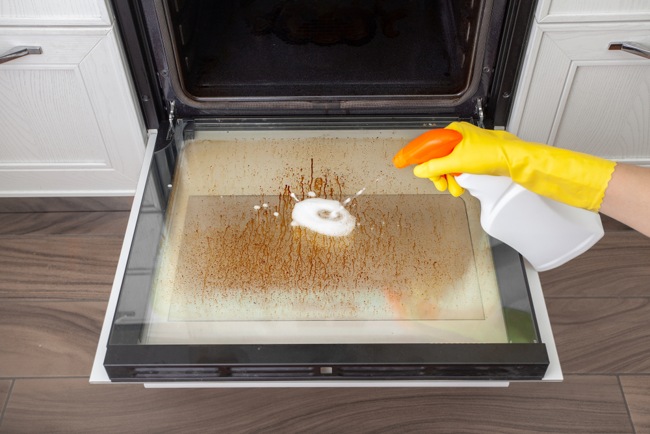
As you can imagine, many oven cleaning products tend to contain powerful chemicals to remove stubborn marks, such as grease. This can be problematic to skin and eyes, so it’s vital that you follow the instructions on these products to ensure you are following the instructions properly, including wearing the correct protective equipment and ventilating the room.
However, you may be wondered how to clean an oven naturally instead. It is becoming increasingly popular for people to clean their oven using more natural eco-friendly cleaning products or creating their own using ingredients such as baking soda, vinegar and lemon juice.
You might also like: How to Clean Your Kitchen Without Chemicals
The easiest way to clean an oven without chemicals is to make up a cleaning solution using equal parts baking soda and white wine vinegar. Or, if you don’t have these ingredients, you can make up a mixture of lemon juice and salt and spoon it onto any stubborn areas of grease or food in the oven, before scrubbing off a few hours later.
But whatever cleaning products you are using – natural or shop-bought – you will need a scrubbing brush or scourer. If you have an old toothbrush lying around, this is also good to use for getting into hard-to-reach areas.
How to clean inside an oven
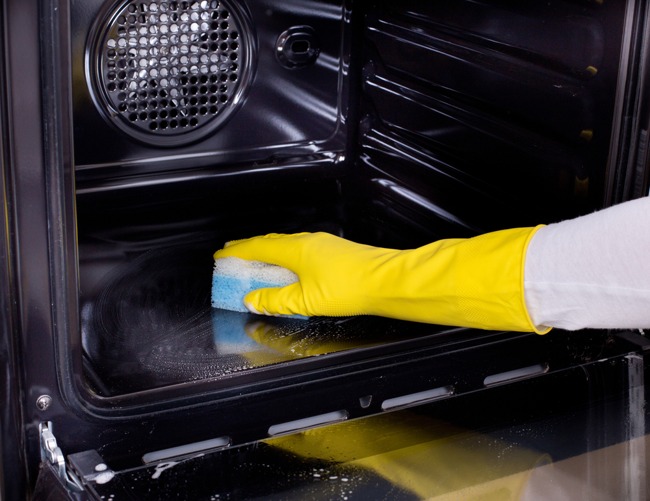
We all know that the inside of your oven is the area most prone to grime, dirt and grease. Follow these simple steps to get your oven looking brand-spanking-new:
1. First things first, start by switching off your oven at the mains. Prep the area by laying out some old newspapers onto the floor to catch any dirt and putting on rubber gloves to prevent the cleaning products from touching your skin.
2. Use a dry brush to scrub off any initial bits of food and dirt.
3. Next, spray the inside of the oven (including the sides) with your chosen cleaning products. Try not to spray the fan/gas supply elements/pilot light in your oven. Leave the product on for the required amount of time.
4. Finally, use your scrubbing brush and scourer to remove the cleaning product and debris.
NOTE: If you’re using baking soda and vinegar paste, it’s a good idea to leave it soaking overnight to maximise success.
How to clean an oven rack
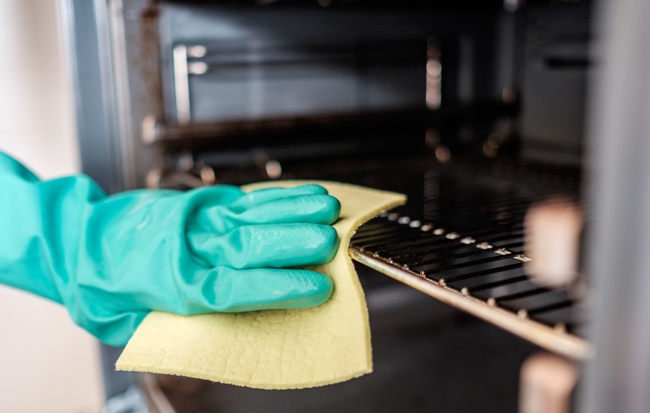
Oven racks are fairly straightforward to clean as you can easily remove and soak them. To do this, you can buy kits at the supermarket that you place your racks inside and add specialist cleaning fluid.
Remember, cleaning fluids can be extremely harsh and corrosive, so make sure you are wearing protective gloves whilst you wash the racks.
Alternatively, you may choose to soak the racks in a large washing up bowl, a bin bag or even a bath instead. But be careful if you have an enamel bath tub, as the cleaning products could be corrosive. Instead, you may want to use a more natural oven cleaning method instead, such as using foil and a dishwasher tablet.
How to clean a glass oven door
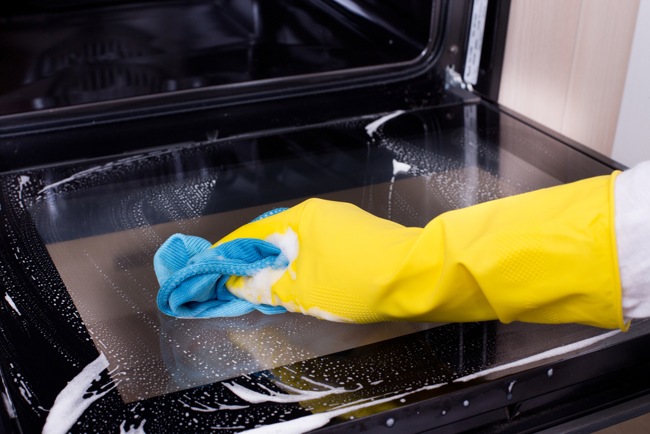
One way to make an instant difference to the appearance of your oven is by cleaning the glass on your oven door. It often gets grimy from cooking and prevents you from seeing what’s going on inside your oven and whether your food is cooking as it should.
As a result, you should clean your over door glass by doing the following:
- Use a glass scraper, sponge or microfiber cloth to remove any foods. It’s important to not use harsh scourers as they may create miniscule scratches onto the glass which may weaken it and make it vulnerable to smashing.
- Depending on your oven, you may be able to remove the glass part of the door for soaking. This will allow you to clean in hard-to-reach areas which grease often builds up. If you want to find out whether you can remove your door, check your oven’s instruction manual.
- Some chemical oven cleaners aren’t suitable for use on glass, so be sure to check before using them. In particular, avoid a caustic-based oven cleaner. Instead, you may want to use standard washing up liquid and water, followed by a vinegar-based solution to leave it streak-free.
- After replacing the glass, it’s a good idea to wipe down the outside of the oven too using a standard kitchen cleaner or warm, soapy water.
How often should you clean your oven?
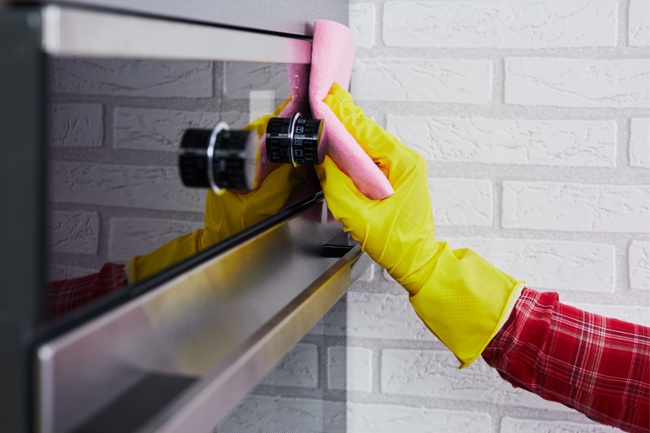
It’s a job that most people put off for months, but that’s the problem. Leaving long gaps between your oven cleaning will make the job much harder and tedious. Therefore, the key is to clean your oven little and often.
Our team recommends wiping down your oven – at the very least – once a month. Furthermore, if you have cooked something that you know has caused a mess in your oven, it’s a good idea to wipe your oven down once it has cooled down.
Another sign of a dirty oven is a burning smell when your oven is turned on and pre-heating. In this case, it’s a good idea to wipe it down (when it’s cooled down) to make it spick-and-span.
How to keep your oven clean
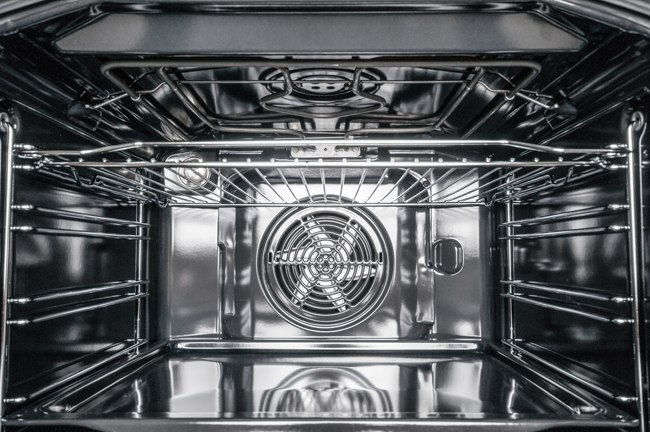
If you really dislike cleaning your oven, there are some things you can do to ensure your oven stays clean for longer. For instance, it’s a good idea to:
- Cover all slow-cooking food with a lid or foil
- Place dishes on a baking tray to avoid food dripping into the oven
Some ovens come with catalytic or pyrolytic linings to help keep your oven as clean as possible. What are the difference between them?
Catalytic oven liners catch, absorb and break down greasy spills straight away, which are burnt away when cooking at over 200 degrees. On the other hand, pyrolytic programs burn off dirt and grease at very high temperatures – usually around 500 degrees. This takes around 2 hours from start to finish, all you have to do is sweep out the dirt and ash afterwards. This isn’t the same as a self-cleaning oven though, as you will still need to clean the oven door and racks by hand.
Alternatively, if you would rather someone completed the job for you, consider calling in professional oven cleaners. Our team are more than happy to help get your oven from dirty to shining clean in no time!
If you’d like to inquire about our cleaning services, please do not hesitate to get in touch with our team.
We provide high-quality cleaning service at an affordable price. Our experienced team of professionals prides themselves in maintaining the highest standards.
When you move out from a rented property, there are a number of things which must be planned and organized. This includes the end of tenancy cleaning, which a large number of landlords are now insisting be done by a professional cleaning company. Our end of tenancy cleaning services are designed to help take the pressure off you and ensure that you are 100% satisfied with the outcome.

